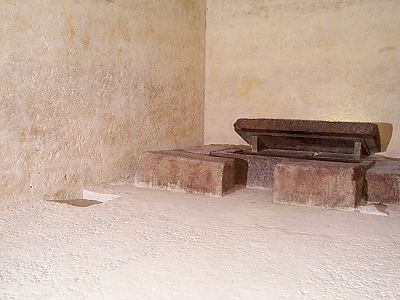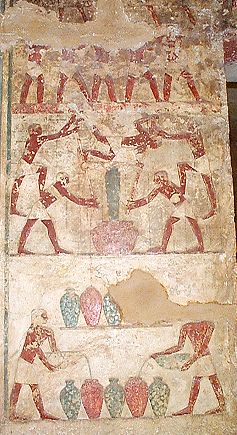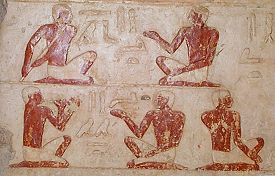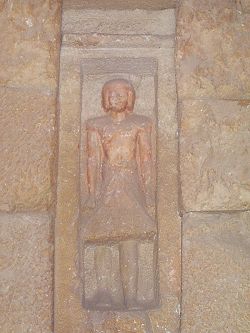| |
The Reopening of the Pyramid of Khafre and Three New Tombs
His Excellency the Minister of Culture, Farouk Hosni, along with Dr. G. A. Gaballah, Secretary General of the Supreme Council of Antiquities, and Dr. Zahi Hawass, Undersecretary of State for the Giza Monuments, announce the reopening of the Pyramid of Khafre, and simultaneously announce the closing of the Pyramid of Menkaure for a period of one year. In addition, three other tombs are being opened to the public.
The Pyramid of Khafre
The Pyramid of Khafre was closed in January of 1999 after humidity levels within the pyramid's chambers had risen to over 80%, due in large part to the increase in the number of visitors inside the pyramid. This had also led to the buildup of salt deposits on the inner walls of the pyramid.

The pyramid was closed under a plan of site management developed for the Giza plateau which tries to set a balance between the demands of tourism, an important source of national revenue, and the simultaneous need for conserving Egypt's monuments. The plan, therefore, operates on a rotation schedule whereby each year one pyramid is closed for cleaning and renovation, while the other two pyramids remain open to the public. Additionally, new tombs are opened each year to the public, while others are closed for renovation and cleaning.
The directors of the monuments had put together a team of Egyptian archaeologists, conservators and architects to work on this plan throughout the past year, and they have completed the required renovation and cleaning efforts, which included:

(1) removal of graffiti which visitors have left on the walls of the pyramid's passageways and the King's chamber
(2) mechanical removal of the salt buildup from the walls
(3) a complete treatment for the floor within the pyramid, consisting of removal of the stone blocks around the granite sarcophagus which were placed there during a previous conservation effort, and replacement of these blocks with others that better suit the stone floor
(4) complete change of the stairs, the comers of which have been reinforced with iron
(5) removal of some of the old finishing mortar which was detaching from the wall, and refinishing with a more modem, stronger mortar composed of sand and lime
(6) installation of a new lighting system within the pyramid which better suits the greatness of its *inner structure
The New Tombs
Three new tombs had been chosen for minute, structural restoration, and are now being reopened to the public. These tombs are situated within the Western Cemetery of the Pyramid of King Khufu, and comprise the private tombs of the officials connected with King Khufu. The work of building these tombs began 'in the fifth year of the reign of King Khufu, and the tombs date from the Fourth Dynasty through to the end of the Old Kingdom in the Eighth Dynasty. The Western cemetery takes the shape of long streets intersected by cross streets, just like the city that they lived in during their lifetimes.
(1) The Tomb of Dua En Re

Dua En Re was the son of King Khafre and Queen Mersy Ankh the Third. The most important of his titles was Minister of King Menkaure. His tomb dates back to the Fourth Dynasty of the Old Kingdom, and the most important architectural feature of his tomb is that the entrance is on the eastern side, and it extends through a passageway into the burial chapel. In its western wall, two false doors are found, as well as an opening to a "serdab" in the south wall.

The most important scene on the walls of the tomb is the scene which depicts the tomb's owner crawling with his subjects behind him, followed by some of the men and ladies carrying the altar and some men preparing groups of animals.
(2) The Tomb of Imry
 His tomb is located next to that of his father, "Shipses Kaf Ankh". Imry's principle title was "Priest of King Khufu and Administrative Overseer of the Royal Court." His tomb, which dates back to the Fifth Dynasty of the Old Kingdom, is located in the southwestern comer of the Western cemetery, and includes a number of extraordinary
examples of vividly colored paintings covering the walls. One that stands out is a drawing that depicts most of the practices of everyday life. As for the architectural planning of the tomb, the entrance lies on the Eastern wall and is topped by a column bearing the name of the tomb's owner. The entrance leads to a rectangular room on the northern wall of which is found an entrance which opens out onto an open courtyard devoid of any drawings or inscriptions. The western wall contains an entrance which leads to the offering chamber which contains a false door on its western side. If we return to the rectangular room, we find on its southern side three openings, behind which is an architectural element known as "al-serdab." One of the most important aspects of the tomb is *in the small vestibule which is adjacent to the tomb's entrance. Here is found a group of scenes, the most important of which are scenes representing industries, such as the craft furniture making; some carpenters are seen cutting wood with saws, working with metals and skins, making jewelry, and pressing oils; other scenes depict artists carving statues, and some of the offering bearers who are making their way towards the deceased owner of the tomb. This is in addition to a special scene on the western wall which depicts the production of beer in all of its stages.
His tomb is located next to that of his father, "Shipses Kaf Ankh". Imry's principle title was "Priest of King Khufu and Administrative Overseer of the Royal Court." His tomb, which dates back to the Fifth Dynasty of the Old Kingdom, is located in the southwestern comer of the Western cemetery, and includes a number of extraordinary
examples of vividly colored paintings covering the walls. One that stands out is a drawing that depicts most of the practices of everyday life. As for the architectural planning of the tomb, the entrance lies on the Eastern wall and is topped by a column bearing the name of the tomb's owner. The entrance leads to a rectangular room on the northern wall of which is found an entrance which opens out onto an open courtyard devoid of any drawings or inscriptions. The western wall contains an entrance which leads to the offering chamber which contains a false door on its western side. If we return to the rectangular room, we find on its southern side three openings, behind which is an architectural element known as "al-serdab." One of the most important aspects of the tomb is *in the small vestibule which is adjacent to the tomb's entrance. Here is found a group of scenes, the most important of which are scenes representing industries, such as the craft furniture making; some carpenters are seen cutting wood with saws, working with metals and skins, making jewelry, and pressing oils; other scenes depict artists carving statues, and some of the offering bearers who are making their way towards the deceased owner of the tomb. This is in addition to a special scene on the western wall which depicts the production of beer in all of its stages.

A scene depicting musicians
(3) The Tomb of Neferbau Petah
This tomb is located in the Western Cemetery. The most important title of its owner is "Overseer of the Royal Estates." It dates back to the middle of the Fifth Dynasty of the Old Kingdom. Architecturally speaking, the tomb contains an entrance on the eastern side which opens out onto an open courtyard in the middle of which are two pillars.
 In its western wall is a statue of the tomb's owner carved in stone. On the south side is an entrance which leads to a square room with two pillars in the center, and on its western wall is an entrance leading to the altar stone. Some of the most important drawings in this tomb are found in the rectangular room, where there are scenes depicting men leading animals which bear the agricultural products and some writings which record the amounts of the crops, along with some of the agricultural activities. In its western wall is a statue of the tomb's owner carved in stone. On the south side is an entrance which leads to a square room with two pillars in the center, and on its western wall is an entrance leading to the altar stone. Some of the most important drawings in this tomb are found in the rectangular room, where there are scenes depicting men leading animals which bear the agricultural products and some writings which record the amounts of the crops, along with some of the agricultural activities.
To prepare these three tombs for reopening to the public, work has been done along two main lines:
(1) The first principle encompasses architectural restoration to the tombs where it was found that they had lost some of their stones and side walls; in addition, parts of the ceilings had been destroyed since the time that the tombs were discovered. Architects specializing in the field of archaeological structures were able to replace and complete the destroyed parts, strengthen the existing walls and ceilings of the tombs, and make sure of the architectural soundness of the other parts. They did the necessary construction of doors, and lighting specialists installed an electrical system to light the tombs using "cold light," a special kind of lighting which does not damage the drawings and inscriptions, while providing a clear view of these drawings for visitors.
(2) The second principle consists of more minute restoration, which included removal of salts from the walls of the tombs, strengthening the paintings, and fixing their colors.
The Pyramid of Menkaure
Today the third pyramid will be closed to the public for a period of one year for the same work of restoration, which was done on the second pyramid.
BACK
to The Plateau Homepage
|
|




 His tomb is located next to that of his father, "Shipses Kaf Ankh". Imry's principle title was "Priest of King Khufu and Administrative Overseer of the Royal Court." His tomb, which dates back to the Fifth Dynasty of the Old Kingdom, is located in the southwestern comer of the Western cemetery, and includes a number of extraordinary
examples of vividly colored paintings covering the walls. One that stands out is a drawing that depicts most of the practices of everyday life. As for the architectural planning of the tomb, the entrance lies on the Eastern wall and is topped by a column bearing the name of the tomb's owner. The entrance leads to a rectangular room on the northern wall of which is found an entrance which opens out onto an open courtyard devoid of any drawings or inscriptions. The western wall contains an entrance which leads to the offering chamber which contains a false door on its western side. If we return to the rectangular room, we find on its southern side three openings, behind which is an architectural element known as "al-serdab." One of the most important aspects of the tomb is *in the small vestibule which is adjacent to the tomb's entrance. Here is found a group of scenes, the most important of which are scenes representing industries, such as the craft furniture making; some carpenters are seen cutting wood with saws, working with metals and skins, making jewelry, and pressing oils; other scenes depict artists carving statues, and some of the offering bearers who are making their way towards the deceased owner of the tomb. This is in addition to a special scene on the western wall which depicts the production of beer in all of its stages.
His tomb is located next to that of his father, "Shipses Kaf Ankh". Imry's principle title was "Priest of King Khufu and Administrative Overseer of the Royal Court." His tomb, which dates back to the Fifth Dynasty of the Old Kingdom, is located in the southwestern comer of the Western cemetery, and includes a number of extraordinary
examples of vividly colored paintings covering the walls. One that stands out is a drawing that depicts most of the practices of everyday life. As for the architectural planning of the tomb, the entrance lies on the Eastern wall and is topped by a column bearing the name of the tomb's owner. The entrance leads to a rectangular room on the northern wall of which is found an entrance which opens out onto an open courtyard devoid of any drawings or inscriptions. The western wall contains an entrance which leads to the offering chamber which contains a false door on its western side. If we return to the rectangular room, we find on its southern side three openings, behind which is an architectural element known as "al-serdab." One of the most important aspects of the tomb is *in the small vestibule which is adjacent to the tomb's entrance. Here is found a group of scenes, the most important of which are scenes representing industries, such as the craft furniture making; some carpenters are seen cutting wood with saws, working with metals and skins, making jewelry, and pressing oils; other scenes depict artists carving statues, and some of the offering bearers who are making their way towards the deceased owner of the tomb. This is in addition to a special scene on the western wall which depicts the production of beer in all of its stages.
 In its western wall is a statue of the tomb's owner carved in stone. On the south side is an entrance which leads to a square room with two pillars in the center, and on its western wall is an entrance leading to the altar stone. Some of the most important drawings in this tomb are found in the rectangular room, where there are scenes depicting men leading animals which bear the agricultural products and some writings which record the amounts of the crops, along with some of the agricultural activities.
In its western wall is a statue of the tomb's owner carved in stone. On the south side is an entrance which leads to a square room with two pillars in the center, and on its western wall is an entrance leading to the altar stone. Some of the most important drawings in this tomb are found in the rectangular room, where there are scenes depicting men leading animals which bear the agricultural products and some writings which record the amounts of the crops, along with some of the agricultural activities.